By Leyla Santiago, Faith Karimi and Nicole Chavez, CNN
Updated 11:35 AM ET, Wed January 8, 2020
Guanica, Puerto Rico (CNN)Puerto Rico residents spent the night outside as aftershocks rocked the island following a magnitude 6.4 earthquake that knocked out power and water services in some areas.
The quake was the strongest and likely the most damaging of hundreds of temblors that have struck the island since December 28. It hit before dawn Tuesday, leaving a man dead and causing dozens of homes and structures to crumble.
It was centered off Puerto Rico's southern coast, 6 miles south of Indios. Gov. Wanda Vázquez Garced declared a state of emergency and activated the Puerto Rico National Guard as she pleaded with residents to remain calm and prepare for aftershocks.
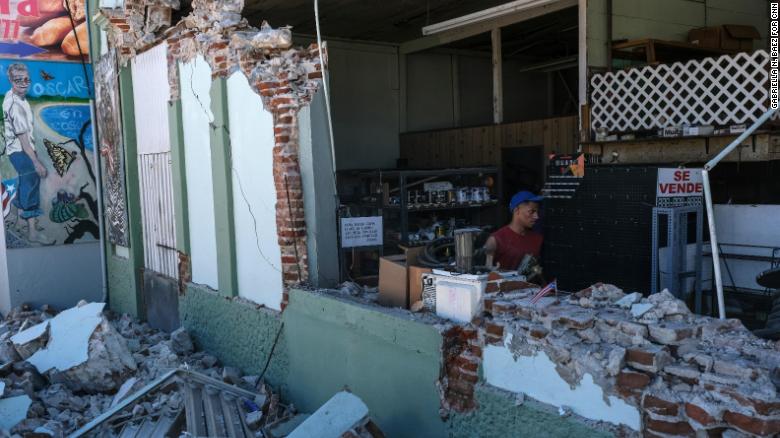
Shop owners and employees help clear the rubble of a collapsed hardware store in Guanica.
Terrified of sleeping indoors as aftershocks continue, neighbors put mattresses in their front yards while others spent the night Tuesday under white tents and tarps.
Riko Gonzalez and his parents were asleep in their home in Yauco, near Indios, when the quake struck. They scurried out of the house as dishes tumbled to the kitchen floor, he said.
Hundreds of aftershocks have hit the area in the past few days.
"People are afraid to go to bed, to then be woken up to worse earthquakes than the day before," Gonzalez said.
Water and power still an issue
Much of Puerto Rico is still without power Wednesday as engineers work to restore it in phases. About 500,000 customers are back on the grid, the Electric Energy Authority said in a tweet.
A system-wide power outage was reported after the Costa Sur power plant near Guayanilla suffered severe damage Tuesday, Vázquez Garced said.
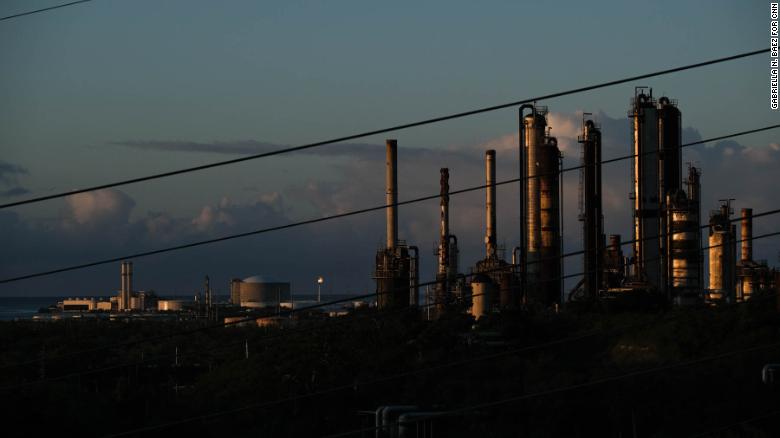
The Costa Sur powerplant located in Valle Tallaboa, near Guayanilla, was damaged in the quakes.
"We lost the largest plant in the entire system," said Jose Ortiz, executive director of the Electric Power Authority.
Power has been restored in most hospitals, and crews are working to fully restore it by the weekend, Ortiz said. A nursing home in Ponce was evacuated and dozens of people in wheelchairs were waiting outside.
Other towns affected by earthquakes are Guanica and Yauco.
Classes have not resumed
Classes won't resume across the island until crews inspect all schools and confirm buildings are safe for students, education officials announced.
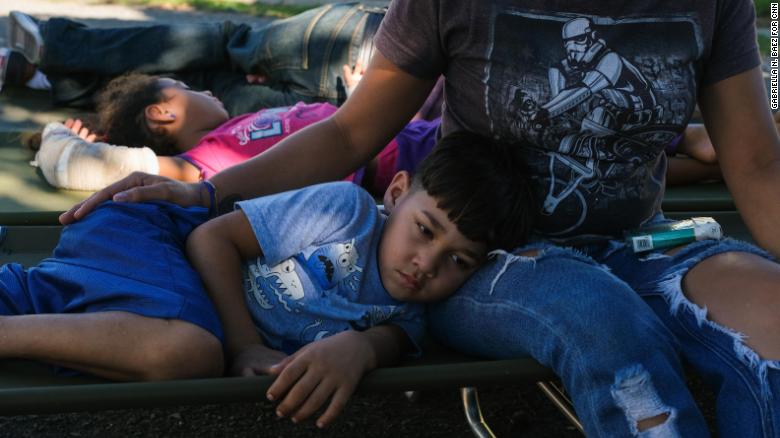
Jasmin Negron Lopez, 28, and her family take refuge at a coliseum in Guanica.
The Agripina Seda School in Guanica suffered major damage Tuesday, including a partially collapsed, three-story building.
"Classes in the public school system won't resume until a total evaluation of all campuses," Education Secretary Eligio Hernández Pérez tweeted, adding that teachers and staff won't return to the schools until further notice.
Damage worse than hurricane, official says
The earthquakes come after Hurricane Maria devastated the US territory in September 2017. Many in southern Puerto Rico said the earthquakes' damage was worse.
"There's no warnings for this," Puerto Rico Police Commissioner Henry Escalera said of the earthquakes. "A hurricane gives us time to plan ahead."
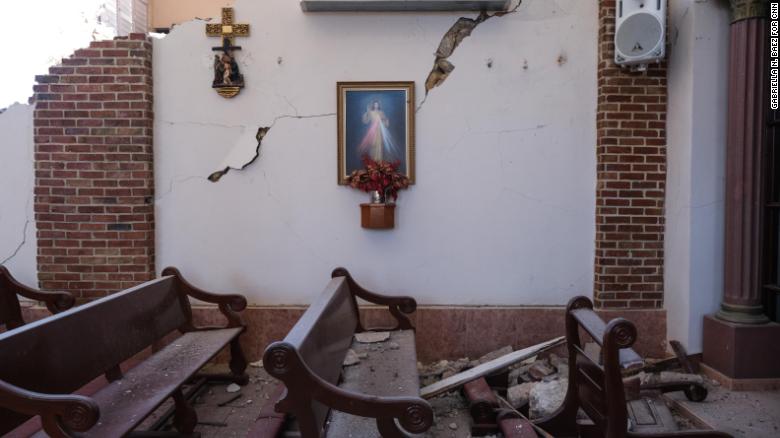
The quake wrecked the historic Inmaculada Concepcion Church in Guayanilla.
When asked what concerns him the most about the quakes' aftermath, he said, "That homes will not be safe to live in and the possibility of a collapse that will cause a person's death or serious injuries."
The Federal Emergency Management Agency announced aid has been made available to supplement local response efforts.
President Donald Trump's action authorizes FEMA to coordinate all disaster relief efforts and provide appropriate assistance for required emergency measures to save lives and protect property.
CNN's Leyla Santiago reported from Puerto Rico, and Nicole Chavez and Faith Karimi reported and wrote from Atlanta. CNN's Angela Barajas contributed to this report.
'No power. No water. Nothing.' Deadly earthquake forces many Puerto Ricans to sleep outside
Ryan W. Miller
USA TODAY
Many Puerto Ricans slept outside and woke up to an island still largely without power Wednesday after a string of earthquakes rocked their home in recent days.
The worst quake – a magnitude 6.4 that struck early Tuesday – killed at least one person, injured at least nine others and caused the power outage that has left about half a million people in the U.S. territory without electricity as of Wednesday.
Hundreds of buildings have also been damaged or are close to crumbling, forcing people to pull their beds into the streets in fear that an aftershock could flatten their homes.
"There's no power. There's no water. There is nothing. This is horrible," 80-year-old Lupita Martínez told the Associated Press as she sat in a parking lot with her husband.
According to the U.S. Geologic Survey, there have been more than 950 earthquakes and aftershocks recorded in the area as of Tuesday night since Dec. 31, though many were weak and could not be felt.
U.S. Federal Emergency Management Agency officials said Tuesday aid had been made available to help the recovery efforts after President Donald Trump signed an emergency declaration.
"All of Puerto Rico has seen the devastation of this earthquake," Gov. Wanda Vázquez told Reuters. Vázquez took office in August in the wake of massive protests and scandal that led Ricardo Rosselló to step down.

Vázquez also declared an emergency and mobilized the national guard as more than 1,000 people were in government shelters in the southwest of the island.
Guánica, among the worst hit towns in the southwest, had to move about 200 people outside a shelter after quakes threatened the structure. They had been staying there because previous earthquakes damaged their homes.
"We are confronting a crisis worse than Hurricane Maria," said Guánica Mayor Santos Seda about the town of 1,500 people.
Nearly 700 homes are close to collapsing and about 150 have already been affected, he said.
"I am asking for empathy from the federal government," he added.
The powerful earthquake Tuesday was the strongest the island has seen in more than a century and comes as many areas are still recovering from the devastation of the deadly Hurricane Maria in 2017, which killed thousands.
Earthquake:What Puerto Rico tourists need to know
Many were critical of the federal government's response to Hurricane Maria, saying more could have been done to aid the recovery efforts.
Schools were still closed Wednesday and most government employees were told to stay home from work. According to Reuters, power should return to much of the island within the next day or two, barring no other large aftershocks or quakes.
The quakes have also destroyed a popular tourist landmark, Punta Ventana, a coastal rock formation that had formed a sort of rounded window. The Puerto Rico Tourism Company confirmed that two other sites, Cueva Ventana and Ruinas del Faro, also suffered irreparable damage.
Contributing: The Associated Press. Follow USA TODAY's Ryan Miller on Twitter @RyanW_Miller
25 PHOTOS SHOW
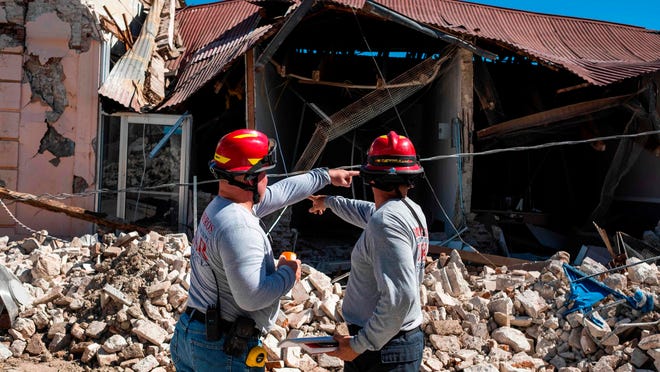 |
| https://www.usatoday.com/picture-gallery/news/nation/2020/01/07/puerto-rico-earthquakes-cause-heavy-damage-and-knock-out-power/2830812001/ |
Many residents afraid to go indoors after Puerto Rico's strongest earthquake since 1918
A day after Puerto Rico's most powerful earthquake in more than a century, scientists warn it's impossible to predict when the tremors will stop. The 6.4 magnitude quake, Puerto Rico's strongest since 1918, leveled buildings and killed at least one man in the southern part of the island early Tuesday morning, leaving more than 300 people homeless.
There have been nearly 1,000 tremors in roughly the last week alone and a state of emergency is now in effect. It's just the latest blow to a community that is still feeling the lasting devastation of Hurricane Maria.
In Guanica, signs of the earthquake are everywhere. There are downed power lines, buildings reduced to rubble, and cars crushed beneath crumbled foundations. In some areas, it looks like a bomb went off.
First responders handed out water, provided medical care, and dispersed cots for hundreds of displaced residents as they prepared to settle in for the night.
Correspondent David Begnaud said there are people who feel safer outside than they do in their own homes because they've been dealing with earthquakes, as one woman said, seemingly almost every hour for the last seven days.
"[I've] never seen anything like this," Felix Rodriguez said. "Never."
Rodriguez kept watch over his elderly neighbor Tuesday night. Elsewhere, Rosalie Torres kept her children, 2 and 5 years old, close.
"We woke up. We'd been thrown around. Everything was shaking back and forth, back and forth. Everybody [kept] falling back down," Torres said.
"Boom, and then it started shaking, everybody started screaming, running, people on the floor," Torres' mother-in-law Noelia DeJesus said.
DeJesus told correspondent David Begnaud the family had just finished fixing the damage to their home inflicted by Hurricane Maria. Now, they'll be forced to start over again.
"Really, we don't have no place to stay because our house collapsed," DeJesus said. "I lost everything."
Puerto Rico's governor Wanda Vázquez Garced said Tuesday there was no way to prepare for the earthquake and warned families to evacuate because property can be replaced, but lives cannot.
The earthquake also destroyed a famous Puerto Rican landmark and natural wonder: The Punta Ventana arch.
Meanwhile, the Trump administration is monitoring the situation in Puerto Rico, and has authorized FEMA to coordinate relief efforts.
© 2020 CBS Interactive Inc. All Rights Reserved.
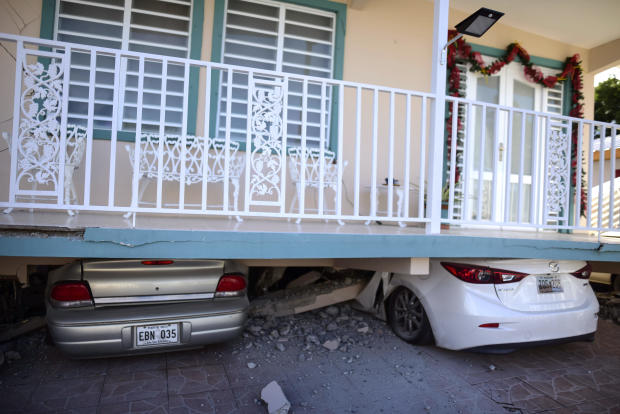
No comments:
Post a Comment